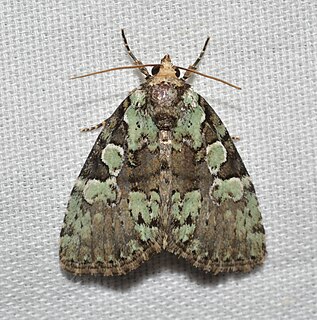
Daphnis nerii, the oleander hawk-moth or army green moth, is a moth of the family Sphingidae. It was described by Carl Linnaeus in his 1758 10th edition of Systema Naturae.
Colomychus is a genus of moths of the family Crambidae.
Geshna is a monotypic moth genus of the family Crambidae described by Harrison Gray Dyar Jr. in 1906. It contains only one species, Geshna cannalis, the lesser canna leafroller, described by Altus Lacy Quaintance in 1898. It is found in North America, where it has been recorded from Florida, Mississippi, South Carolina, North Carolina and Tennessee. It has also been recorded from Costa Rica and Cuba.
Mimoschinia is a genus of moths of the family Crambidae. It contains only one species, Mimoschinia rufofascialis, the rufous-banded pyralid moth or barberpole caterpillar, which is found in the Caribbean, from Alberta to British Columbia, south to Texas and California and in Mexico.

Leuconycta lepidula, the marbled-green leuconycta moth, marbled-green jaspidia or dark leuconycta, is a moth of the family Noctuidae. The species was first described by Augustus Radcliffe Grote in 1874. It is found in North America from Nova Scotia to North Carolina, west to Texas and north to Alberta.
Cacozelia basiochrealis, the yellow-based cacozelia, is a species of snout moth in the genus Cacozelia. It was described by Augustus Radcliffe Grote in 1878. It is found in the southern part of the United States.

Apantesis anna, the Anna tiger moth, is a moth of the family Erebidae. It was described by Augustus Radcliffe Grote in 1863. It is found from Maine to the mountains of North Carolina, west to Nebraska and Arkansas.

Chrysendeton medicinalis, the bold medicine moth, is a moth in the family Crambidae. It was described by Augustus Radcliffe Grote in 1881. It is found on North America, where it has been recorded from Alabama, Florida, Georgia, Illinois, Indiana, Kentucky, Maryland, Mississippi, North Carolina, Ohio, Pennsylvania, South Carolina, Tennessee, Texas and West Virginia.
Elophila ekthlipsis, the nymphula moth, is a moth in the family Crambidae. It was described by Augustus Radcliffe Grote in 1876. It is found in North America, where it has been recorded from the Great Lakes area, including Indiana, Maine, Michigan, Minnesota, New Brunswick, New Hampshire, Ohio, Ontario, Quebec and Wisconsin. The habitat consists of ponds and marshes.
Elophila nebulosalis, the nebulous munroessa moth, is a moth in the family Crambidae. It was described by Charles H. Fernald in 1887. It is found in North America, where it has been recorded from South Carolina to Florida.
Prorasea simalis is a moth in the family Crambidae. It was described by Augustus Radcliffe Grote in 1878. It is found in North America, where it has been recorded from Alberta, California, Colorado, Nevada and Oregon.

Loxostege allectalis is a moth in the family Crambidae. It was described by Augustus Radcliffe Grote in 1877. It is found in the United States, where it has been recorded from southern California to Texas. To the south, the range extends into Mexico and Central America.
Loxostege anartalis is a moth in the family Crambidae. It was described by Augustus Radcliffe Grote in 1878. It is found in North America, where it has been recorded from coast to coast in Canada. In the west, the range extends south to California.
Pyrausta tatalis is a moth in the family Crambidae. It was described by Augustus Radcliffe Grote in 1877. It is found in North America, where it has been recorded from California to Texas and Oklahoma.
Donacaula aquilella is a moth in the family Crambidae. It was described by James Brackenridge Clemens in 1860. It is found in North America, where it has been recorded from Alabama, Georgia, Massachusetts, Mississippi, New Jersey, New York, North Carolina and South Carolina.
Colomychus florepicta is a moth in the family Crambidae. It was described by Harrison Gray Dyar Jr. in 1914. It is found in San Luis Potosí, Mexico.

Diacme adipaloides, the darker diacme moth, is a moth in the family Crambidae. It was described by Augustus Radcliffe Grote and Coleman Townsend Robinson in 1867. It is found in North America, where it has been recorded from Alabama, Arkansas, Florida, Indiana, Maine, Maryland, Massachusetts, Michigan, Minnesota, New Brunswick, New Hampshire, New Jersey, New York, North Carolina, Nova Scotia, Ohio, Oklahoma, Ontario, Quebec, South Carolina, Tennessee, Texas, Virginia, West Virginia and Wisconsin.

Baileya australis, the small baileya moth, is a moth of the family Nolidae. The species was first described by Augustus Radcliffe Grote in 1881. It is found in North America, where it has been recorded from Quebec and New York to Florida, west to Texas, north to North Dakota and Ontario.
Loxomorpha flavidissimalis is a moth in the family Crambidae. It was described by Augustus Radcliffe Grote in 1877. It is found in the United States, where it has been recorded from Texas, Florida, North Carolina and West Virginia. It is also found in Mexico and Puerto Rico. It has also been recorded from Australia.
Mecyna submedialis, the orange-toned mecyna moth, is a moth in the family Crambidae. It was described by Augustus Radcliffe Grote in 1876. It is found in North America, where it has been recorded from Ontario and Michigan, south to Florida and west to Arkansas. It has also been recorded from Alberta.







